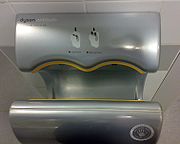
Dyson Airblade
Encyclopedia
The Dyson Airblade is a model of electric hand dryer
made by the Wiltshire
, UK based company Dyson. It was introduced in the UK in 2006 and in the United States in latter part of 2007. Instead of using a wide jet of heated air, it uses a layer of unheated air traveling at around 400 miles per hour. The Dyson Airblade is reported by its manufacturer to dry hands in 10 seconds and use less electricity than conventional hand dryers.
The first commercially available high speed, horizontal wiping air dryer was the Mitsubishi Jet Towel, invented in 1993 and available in the United States since 2005. There are several technical distinctions between such dryers, such as airspeed, water containment, energy efficiency, use of heat, type of filter, motor lifespan and power usage.
Since its release, the Dyson Airblade has won several awards including the Best Overall Product at Interbuild 2007 and Best workplace product innovation.
 In the United States, Dyson worked with the NSF to become the only certified hand dryer under Protocol P335 for Hygienic Commercial Hand Dryers The Royal Society of Public Health has given the Dyson Airblade hand dryer its first hygiene accreditation. It is also endorsed by the British Skin Foundation, HACCP International, Campden BRI and IRM.
In the United States, Dyson worked with the NSF to become the only certified hand dryer under Protocol P335 for Hygienic Commercial Hand Dryers The Royal Society of Public Health has given the Dyson Airblade hand dryer its first hygiene accreditation. It is also endorsed by the British Skin Foundation, HACCP International, Campden BRI and IRM.
A paper was presented at the 17th European Congress of Clinical Microbiology and Infectious Diseases, Munich, Germany in 2007 by the University of Bradford
and Dyson showing that for a set drying time of 10 seconds, the Airblade led to significantly less bacterial transfer than with the other driers (p < 0.05). When the latter were used for longer (30–35 s) the trend was for the Airblade to still perform better, however these results did not reach statistical significance (p > .05). In addition the study showed that rubbing hands whilst using the driers counteracted the reduction in overall bacterial numbers at all anatomical sites.
Hygiene associated with the product has been questioned in research by the University of Westminster Trade Group, London and sponsored by the paper towel industry the European Tissue Symposium, which suggests that use increases the amount of bacteria on the hands by at least 42%.
Hand dryer
Hand dryers are electric devices found in public washrooms that are used to dry hands. They may either operate with a button or automatically using an infrared sensor.- Costs :...
made by the Wiltshire
Wiltshire
Wiltshire is a ceremonial county in South West England. It is landlocked and borders the counties of Dorset, Somerset, Hampshire, Gloucestershire, Oxfordshire and Berkshire. It contains the unitary authority of Swindon and covers...
, UK based company Dyson. It was introduced in the UK in 2006 and in the United States in latter part of 2007. Instead of using a wide jet of heated air, it uses a layer of unheated air traveling at around 400 miles per hour. The Dyson Airblade is reported by its manufacturer to dry hands in 10 seconds and use less electricity than conventional hand dryers.
The first commercially available high speed, horizontal wiping air dryer was the Mitsubishi Jet Towel, invented in 1993 and available in the United States since 2005. There are several technical distinctions between such dryers, such as airspeed, water containment, energy efficiency, use of heat, type of filter, motor lifespan and power usage.
Since its release, the Dyson Airblade has won several awards including the Best Overall Product at Interbuild 2007 and Best workplace product innovation.
Efficiency
The Airblade can be more energy efficient than conventional hand-dryers because it runs for a shorter time than conventional driers and doesn't use heat to dry hands.Hygiene

A paper was presented at the 17th European Congress of Clinical Microbiology and Infectious Diseases, Munich, Germany in 2007 by the University of Bradford
University of Bradford
The University of Bradford is a British university located in the city of Bradford, West Yorkshire, England. The University received its Royal Charter in 1966, making it the 40th University to be created in Britain, but its origins date back to the early 1800s...
and Dyson showing that for a set drying time of 10 seconds, the Airblade led to significantly less bacterial transfer than with the other driers (p < 0.05). When the latter were used for longer (30–35 s) the trend was for the Airblade to still perform better, however these results did not reach statistical significance (p > .05). In addition the study showed that rubbing hands whilst using the driers counteracted the reduction in overall bacterial numbers at all anatomical sites.
Hygiene associated with the product has been questioned in research by the University of Westminster Trade Group, London and sponsored by the paper towel industry the European Tissue Symposium, which suggests that use increases the amount of bacteria on the hands by at least 42%.

